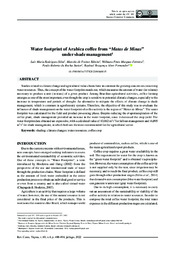Water footprint of Arabica coffee from "Matas de Minas" under shade management.
Water footprint of Arabica coffee from "Matas de Minas" under shade management.
Author(s): SILVA, L. M. R.; RIBEIRO, M. de F.; FERREIRA, W. P. M.; ROCHA JUNIOR, P. R. da; FERNANDES, R. B. A.
Summary: Studies related to climate change and agricultural value chains have in common the growing concern on conserving water resources. Thus, the concept of the water footprint stands out, which measures the amount of water (in volume) necessary to produce a unit (in mass) of a given product. Among Brazilian agricultural activities, coffee farming emerges as one of the most important, even though the crop is sensitive to potential climatic changes, especially to the increase in temperature and periods of drought. An alternative to mitigate the effects of climate change is shade management, which is common in agroforestry systems. Therefore, the objective of this study was to evaluate the influence of shade management on the water footprint of coffee activity in the region of "Matas de Minas". The water footprint was calculated for the field and product processing phase. Despite reducing the evapotranspiration of the coffee plant, shade management provided an increase in the water footprint, since it decreased the crop yield. The water footprint data obtained are expressive, with a calculated value of 13,862 m3 t -1 for full sun management and 16,895 m3 t -1 for shade management, in which both are the most recommended for the agricultural sector.
Publication year: 2022
Types of publication: Journal article
Unit: Embrapa Coffee
Observation
Some of Embrapa's publications are published as ePub files. To read them, use or download one of the following free software options to your computer or mobile device. Android: Google Play Books; IOS: iBooks; Windows and Linux: Calibre.
Access other publications
Access the Agricultural Research Database (BDPA) to consult Embrapa's full library collection and records.
Visit Embrapa Bookstore to purchase books and other publications sold by Embrapa.

